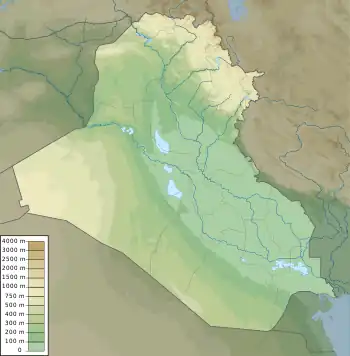Rabana-Merquly
Rabana-Merquly is a cluster of archaeological sites in Sulaymaniyah Governorate, Kurdistan Region, Iraq. It consists of at least two separate fortified settlements, Rabana and Merquly, and at least two rock reliefs, probably all dating to the Middle Parthian period (c. 50-150 CE).[1] It has been suggested that Rabana-Merquly was the site of ancient Natounia or Natounissarokerta, a city that is otherwise only known from coins.[2]
 Rock relief at Merquli depicting a standing man, possibly a king | |
 Location in Iraq  Location in the Near East | |
| Location | Sulaymaniyah Governorate, Iraq |
|---|---|
| Coordinates | 35.750°N 45.229°E |
| Type | Archaeological site |
| Area |
|
| History | |
| Periods | Parthian Empire |
| Site notes | |
| Excavation dates | 2009; 2016; 2017 |
History of research
Excavations by the Sulaimaniyah Directorate of Antiquities took place at Merquly in 2009. Rabana was studied in 2016-2017 by a team from Heidelberg University and the Iraqi-Kurdistan Directorate of Antiquities.[1]
In June 2022, it was announced that researchers believe a rock relief was a king of Adiabene meaning a nearby fortress is the lost city of Natounia in the Kurdish region of Iraq.[3]
According to Arab News, "researchers from the Directorate of Antiquities in Sulaymaniyah in Iraqi Kurdistan, together with Dr. Michael Brown of Germany’s Heidelberg University, say that the established fortification site of Rabana-Merquly could house the ruins of Natounia."[4]
See also
References
- Brown, Michael; Miglus, Peter; Rasheed, Kamal; Ahmad, Mustafa (2018). "Portraits of a Parthian King: Rock-Reliefs and the Mountain Fortresses of Rabana-Merquly in Iraqi Kurdistan". Iraq. 80: 63–77. doi:10.1017/irq.2018.5. ISSN 0021-0889. S2CID 96440936.
- Katie Hunt. "Ancient fortress found by archaeologists may be a lost royal city". CNN. Retrieved 2022-07-20.
- Magazine, Smithsonian; Solly, Meilan. "Why Archaeologists Think They've Found the Lost City of Natounia". Smithsonian Magazine. Retrieved 2022-07-28.
- "Hill fort in Iraqi Kurdistan could be lost city of Natounia: Researchers | Arab News". 2022-07-28. Archived from the original on 2022-07-28. Retrieved 2022-07-31.